I have abdominal separation…What do I do??
First of all, don’t worry or panic or believe scaremongering articles online! Almost everyone will have abdominal separation during pregnancy and therefore the separation will be there after the baby is born.
The separation occurs in one of your four main abdominal muscles: rectus abdominis. The natural separation is nature’s way of allowing for the tummy to relax and stretch to accommodate the growing baby.
So which muscle separates?
The muscle which separates is called “rectus abdominis”. This latin term means “straight muscle of the abdomen”. In other words it’s the muscle that extends from your sternum (breastbone) straight down the middle of your tummy to your pubic bone (bone at the front of your pelvis). It is more commonly known as “the six pack” muscle. I now hear many people saying…”but I never had a six pack muscle”. Well everyone has a six pack. But not everyone has worked it hard, to make it defined into those distinct bumps. We all have the muscle, but not that defined.
In pregnancy, the muscle separates down the middle. There is a band of connective tissue between the 2 halves designed by nature to expand in pregnancy….in other words to separate.
How is my separation measured?
Various measures are used…traditionally you will be asked to lie down. The Physio places three fingers across the muscle below and above the level of the umbilicus (belly button). You are asked to do a half sit up so that the muscle contracts showing how much separation there is in finger widths.
A more accurate measure is with ultrasound. We have ultrasound available for every patient at every consultation. With the ultrasound, an accurate image can be gained. We can accurately measure the separation as you do a small sit up.
In recent years, research has taught us that the separation is natural and the important thing to look for is good formation of strong connective tissue beneath the separation. The tissue will make the separation very shallow. If deep, the connective tissue behind the separation needs lots of work to restore its strength and integrity. We do this by working the lower tummy muscle called “transversus abdominis”. This latin term means “across the abdomen”. This muscles lies across the tummy. It works with your pelvic floor and forms the basis of core exercise.
So if you are worried about abdominal separation you should do the following:
- Don’t panic! Abdominal separation is normal but does need assessment
- Make sure you have the separation graded with a health professional. Midwives will check for you but if you can see a Physio, we will do a check with ultrasound. If your midwife in hospital says the separation is more than 3 fingers, this is considered a large separation. Find a pelvic health Physiotherapist to have an individual assessment to see if the connective tissue behind is formed or needs recovery
- Learn how to activate transversus abdominis with pelvic floor to encourage recovery of the connective tissue.
Pregnancy and childbirth is an amazing thing. Lots of changes happen to muscles and ligaments and connective tissue and in most cases, a little bit of knowledge goes a long way towards fixing up all the deficits that occur. If worried, seek help and pave the way for safe return to exercise.
Feel free to call Caroline Bender on 0437552009 if you would like to discuss your concerns about abdominal separation.



